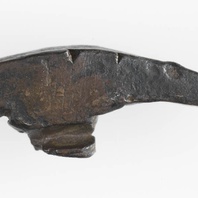
Viking Objects
Silver Thor’s Hammer Pendant (CM_1841_2008)
This is a high quality hammer-head section of a silver Thor’s hammer pendant. These may have been worn to show devotion to the god Thor, or to secure the god’s protection, although there is little evidence to support this interpretation. Pendants like this have been found made of lead, copper alloy, silver and gold, showing that many different strata of society could have worn them. For more information on Scandinavian jewellery in England check out our blog: Brooches, Pendants and Pins: Scandinavian Dress Accessories in England.
Read More
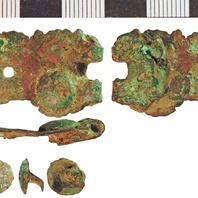
Viking Objects
Frankish Trefoil Buckle (NLM-60D592)
This cast copper-alloy buckle plate is trefoil in form and has traces of gilding which appear on the display side. The use of tripled domed rivets is similar to Frankish buckle styles introduced from the seventh century, while the use of gilding may relate this to eighth-century styles. It is possible that it made its way to England prior to Viking incursions but it is equally likely that the Vikings brought this buckle with them as plunder after raiding in Frankia.
Read More
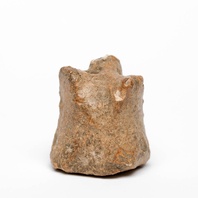
Viking Objects
Lead Gaming Piece (CM.574-2010)
This solid sub-circular based lead gaming piece has three projections on the top. This and similar pieces have also been interpreted as weights although the gaming piece interpretation is more secure. Pieces like this would have been used to play hnefatafl and/or Nine Men’s Morris, both of which are known to have been played in Scandinavia in the Viking Age.
Read More
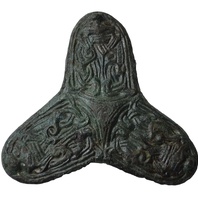
Viking Objects
Trefoil brooch (LCNCC : 2011.99)
A trefoil brooch with Borre/Jellinge-style cast ornament belonging to Peterson’s type 109. The brooch is most probably cast of copper alloy with traces of gilding on its upper surface and white metal plating on the reverse. While of Scandinavian design, many examples found in the East Midlands were probably made in the Danelaw, and may have been copies of Scandinavian styles, instead of being imported from Scandinavia. For more information on Scandinavian jewellery in England check out our blog: Brooches, Pendants and Pins: Scandinavian Dress Accessories in England.
Read More

Viking Names
Ketsby
Ketsby, in the Hill Wapentake of Lincolnshire, comes from the Old Norse male personal name Ketill and the Old Norse element by ‘farmstead, village’. It is a joint parish with South Ormsby.
Read More
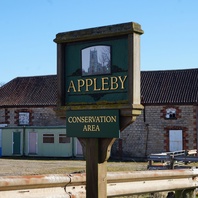
Viking Names
Appleby
Appleby, in the Manley Wapentake of Lincolnshire, is a hybrid name coming from Anglian æppel ‘an apple; fruit, tree-fruit; an apple-tree’ and Old Norse by ‘a farmstead, a village’. It is likely, from the situation of the village that this was formerly Appleton, in which the second element, originally Old English tun ‘a farmstead, village, estate’, was later replaced by by.
Read More

Viking Names
Gunness
Gunness, in the Manley Wapentake of Lincolnshire, is an Old Norse compound from the male personal name Gunni and nes ‘a ness, a headland, a promontory’. The name is topographically appropriate as it is located on a marked promontory on the River Trent. The same personal name also occurs in Gunby and Gunthorpe, Lincolnshire.
Read More

Viking Names
Risby
Risby, in the West Riding of Lindsey in Lincolnshire from Old Norse hrís ‘shrubs, brushwood’ and Old Norse by ‘A farmstead, a village’. This name is found as Rejsby and Risby in Denmark and it is possible that the place-name is transferred from there. If this is the case it was presumably because it is topographically appropriate for the English name as for the Danish. Risby is a joint parish with Roxby.
Read More
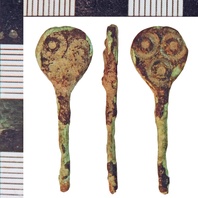
Viking Objects
Ring-and-Dot Pin (NLM-7A2D15)
Copper-alloy cast pin with a flat discoid head, no collar, and stamped decoration on the head, Flixborough type 601. The head bears three large [diameter 4.4mm] ring-and-dot motifs on each of its opposed faces. The tip of the shank is lost. The introduction of flat-headed pins with ring-and-dot decoration, superseding other types, is held by Dave Haldenby to mark the arrival of Viking settlers at Cottam, East Riding of Yorkshire. Suggested date: Early Medieval, 865-925. The finder suggests this to be part of an assemblage amounting to c.5% of material recovered from an extensive site, the rest being removed illicitly without record. Archaeological opinion holds the site to have been of equivalent character to Flixborough, North Lincolnshire, in terms of its material culture. Coins are under-represented in the group.
Read More

Viking Names
Brocklesby
Brocklesby, in the Yarborough Wapentake of Lincolnshire, comes from the postulated Old Norse personal name Bróklauss and the Old Norse element bý ‘a farmstead, a village’. The first element is originally a nickname meaning ‘without breeches’ and is likely an Anglo-Scandinavian formation.
Read More

Viking Names
Tupholme
Tupholme, in the Gartree Wapentake of Lincolnshire, comes from the Old Norse male personal name Túpi and Old Norse holmr ‘an island, an inland promontory, raised ground in marsh, a river-meadow’. Alternatively, the first element may represent Middle English tup ‘a ram, a tup’.
